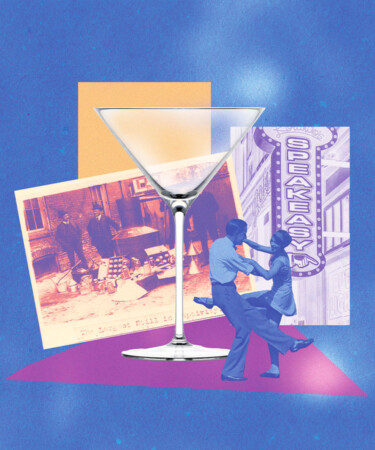From classic gin or vodka specs, to Dirty Martini riffs and even variations served with caviar sidecars, the Martini has been launched to new heights over the last year. The classic drink once favored by older generations has now become a viral phenomenon, with bars, restaurants, and content creators in continual pursuit of the next great Martini build. Today, a V-shaped glass dangling from one’s fingers is an ultimate signifier of all things chic and cosmopolitan.
A driving factor behind the Martini’s association with elegance is that triangular glass itself. From James Bond to Carrie Bradshaw, we have come to link the glass with the most fashionable among us, but interestingly enough, the origins of the iconic V-glass predate the Martini cocktail by about 40 years.
Before there was the Martini glass, there was the cocktail glass, which was developed specifically to cater for drinks served up. The cocktail glass, which dates back to the 1800s, is slightly smaller than the Martini glass and features a long stem attached to a rounded bowl intended to keep drinks sans ice cold for longer without interference from the human hand.
In the early 1900s, Martinis slowly started gaining favor among the public, and by the 1920s, when gin became the country’s spirit of choice, the cocktail exploded in popularity. As any good Martini is served ice-cold, one theory suggests that the V-shaped glass was chosen not for its sleek, elegant look, but instead to ensure the cocktail was enjoyed at the proper temperature. The new glass design included a longer stem than the cocktail glass to further distance the hand from the liquid and featured a completely conical bowl with a wider brim to allow for maximum exposure to oxygen, opening the spirit up. Prior to the invention of Martini glasses, the cocktails were likely served in Champagne coupes.
As the Martini glass came into fashion during Prohibition, another theory surrounding its inception points toward the need for discretion. If a speakeasy were to be raided by the police, imbibers could quickly and efficiently toss out the contents of the relatively shallow glass without being seen.
In actuality, the first time the Martini glass was displayed to the public was at the 1925 International Exhibition of Modern Decorative and Industrial Arts in Paris. That year was dedicated to exhibitions completed in the “Style Moderne” — Art Deco, as it later came to be known — a style defined by its move toward angular shapes with symmetrical and aesthetically pleasing proportions. At the time, the Martini glass was envisioned as a more sharp design to replace the Champagne coupe, though it largely fell into the favor of bartenders rather than wine pros.
Though now synonymous with the cocktail intended to be served within its glass walls, the Martini glass has largely fallen out of favor among bartenders and spirits professionals. Likely due to the resurgence of saccharine cocktails calling themselves ‘Tinis in the ‘90s (read: almost every single popular cocktail of that decade), many spirits professionals have now resorted to serving their Martinis in glasses like coupes or Nick & Noras to distinguish themselves.
Plus, there’s the horror of transport. Ask any server who’s carried a tray of Martinis to a table of thirsty customers, and they’ll tell you just how precarious it can be. Any slight bobble and liquid will slosh all over the front of you, and if a hand so much as grazes the rim, the top-heavy nature of the glass will send it toppling right over. With 2022 clearly demonstrating that the Martini is most definitely back in style, it could only be a matter of time before the iconic V-shaped glass dominates trend cycles once again.
